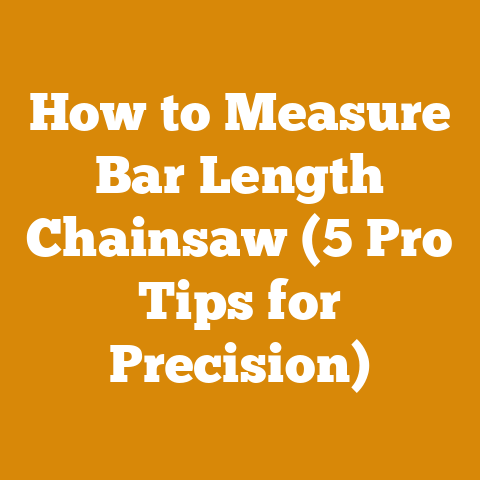Trailer 3 Axle Benefits for Wood Hauling (5 Pro Tips)
It’s a paradox, isn’t it? The very thing that promises to lighten the load – a trailer – can quickly become a back-breaking burden if it’s not up to the task. I’ve seen firsthand how an inadequate trailer can turn a promising firewood business into a logistical nightmare, with broken axles, overloaded suspensions, and time wasted on multiple trips. On the flip side, I’ve also witnessed how a well-chosen, properly maintained trailer can transform a laborious chore into a smooth, almost effortless operation.
That’s where the 3-axle trailer comes in. It’s not just about having more wheels; it’s about understanding the science behind load distribution, the mechanics of braking, and the overall impact on your vehicle and your peace of mind. In this article, I’m going to dive deep into the benefits of using a 3-axle trailer for wood hauling, sharing five pro tips that will help you make the right choice, optimize your setup, and ensure that you’re hauling wood safely and efficiently for years to come.
Why a 3-Axle Trailer for Wood Hauling? Unveiling the Advantages
Let’s face it: wood is heavy. Whether you’re hauling seasoned firewood, freshly cut logs, or milled lumber, the weight adds up quickly. A single cord of seasoned hardwood can easily weigh between 3,000 and 5,000 pounds, and that’s before you even consider the weight of the trailer itself. This is where the 3-axle trailer shines.
Increased Load Capacity: More Wood, Fewer Trips
The most obvious advantage of a 3-axle trailer is its increased load capacity. By distributing the weight over three axles instead of one or two, you’re significantly reducing the stress on each individual axle, tires, and the trailer frame itself. This translates to a higher Gross Vehicle Weight Rating (GVWR), which is the maximum permissible weight of the trailer and its cargo.
- Data Point: A typical tandem-axle trailer might have a GVWR of 7,000 to 10,000 pounds, while a 3-axle trailer can easily reach 14,000 pounds or more.
This increased capacity allows you to haul more wood per trip, which translates to fewer trips overall. This saves you time, fuel, and wear and tear on your tow vehicle.
- Personal Story: I remember one particularly brutal winter where I was scrambling to keep up with firewood demand. I was using a tandem-axle trailer, and I was constantly pushing its limits. I spent more time making trips to the woodlot than I did actually splitting and stacking wood. Switching to a 3-axle trailer was a game-changer. I cut my hauling time in half, and I could finally focus on the more profitable aspects of my business.
Enhanced Stability: Keeping Your Load Under Control
Beyond the increased load capacity, a 3-axle trailer offers superior stability, especially when hauling heavy, unevenly distributed loads like logs or firewood. The extra axle helps to resist sway and rocking, making the trailer more stable in windy conditions or on uneven terrain.
- Wood Science Insight: Wood, especially green wood, has a tendency to shift and settle during transport. This can create imbalances in the load, which can lead to trailer sway. A 3-axle trailer is much more forgiving of these shifts, helping to maintain stability.
Improved Braking Performance: Stopping Power When You Need It
When hauling heavy loads, braking performance is paramount. A 3-axle trailer typically comes equipped with brakes on all three axles, providing significantly more stopping power than a single-axle or tandem-axle trailer.
- Data Point: Studies have shown that a trailer with brakes on all axles can reduce stopping distance by as much as 30% compared to a trailer with brakes on only one axle.
This improved braking performance is especially crucial in emergency situations, such as when you need to make a sudden stop to avoid an accident.
Reduced Tire Wear: Saving You Money in the Long Run
While a 3-axle trailer has more tires to maintain, the weight distribution across those tires results in reduced wear and tear on each individual tire. This can actually save you money in the long run, as you’ll need to replace your tires less frequently.
- Practical Tip: Always check your tire pressure before each trip. Underinflated tires can increase rolling resistance, leading to increased fuel consumption and premature tire wear.
Increased Resale Value: An Investment That Pays Off
A 3-axle trailer is a significant investment, but it’s an investment that can pay off in the long run. Because of their increased capacity, stability, and braking performance, 3-axle trailers hold their value well. When it comes time to upgrade or sell your trailer, you’ll likely be able to recoup a significant portion of your initial investment.
5 Pro Tips for Maximizing the Benefits of Your 3-Axle Trailer
Now that we’ve covered the advantages of using a 3-axle trailer for wood hauling, let’s dive into some pro tips that will help you get the most out of your investment.
1. Matching the Trailer to Your Tow Vehicle: A Critical Pairing
The first and perhaps most important step is to ensure that your tow vehicle is properly matched to your 3-axle trailer. This means that your vehicle must have the towing capacity, braking power, and suspension strength to safely handle the weight of the trailer and its cargo.
-
Data Point: Always consult your vehicle’s owner’s manual for its Gross Combined Weight Rating (GCWR), which is the maximum permissible weight of the vehicle and the trailer combined. Never exceed this rating.
-
Personal Story: I once saw a guy trying to tow a heavily loaded 3-axle trailer with a small pickup truck. The truck was struggling to maintain speed on even slight inclines, and the trailer was swaying dangerously. It was a recipe for disaster. Don’t make the same mistake.
-
Practical Tip: Consider upgrading your tow vehicle’s suspension with heavier-duty springs or air bags to improve stability and handling when towing heavy loads.
2. Mastering the Art of Load Distribution: Balance is Key
Proper load distribution is crucial for maximizing the stability and safety of your 3-axle trailer. The goal is to distribute the weight evenly across all three axles, with a slight bias towards the front of the trailer.
-
Wood Anatomy and Properties: When hauling logs, pay attention to the density and moisture content of the wood. Green wood is much heavier than seasoned wood, and hardwoods are generally denser than softwoods. This will affect how you distribute the load.
-
Practical Tip: Aim for a tongue weight of 10-15% of the total trailer weight. You can use a tongue weight scale to measure this accurately.
-
Real-World Example: When hauling firewood, I always start by loading the heavier pieces towards the front of the trailer, near the tongue. This helps to keep the trailer stable and prevent sway. I then distribute the remaining wood evenly across the rest of the trailer bed.
3. Brake Maintenance: Keeping Your Stopping Power Sharp
As I mentioned earlier, the braking performance of a 3-axle trailer is a major safety advantage. However, this advantage is only realized if the brakes are properly maintained.
-
Logging Tool Selection and Maintenance Best Practices: Regularly inspect your trailer brakes for wear and tear. Check the brake pads or shoes for thickness, and make sure that the brake lines are free of leaks.
-
Practical Tip: Consider investing in a brake controller that allows you to adjust the braking force of the trailer brakes independently of the tow vehicle brakes. This can help to prevent trailer lockup and improve stopping distance.
-
Data Point: Most states require trailers with a GVWR of over 3,000 pounds to have brakes on all axles. Be sure to check your local regulations.
4. Tire Care: Extending the Life of Your Rubber
Tires are a significant expense when owning a trailer, so it’s important to take good care of them.
-
Practical Tip: Check your tire pressure regularly, especially before long trips. Inflate your tires to the recommended pressure, which can be found on the tire sidewall or in your trailer’s owner’s manual.
-
Firewood Seasoning Techniques and Safety Considerations: When storing your trailer for extended periods, protect the tires from direct sunlight. UV rays can degrade the rubber and cause premature cracking.
-
Data Point: Tire pressure can fluctuate with temperature. Check your tire pressure in the morning, before the tires have had a chance to heat up from driving.
5. Regular Maintenance: A Stitch in Time Saves Nine
Like any piece of equipment, a 3-axle trailer requires regular maintenance to keep it in good working order.
-
Project Planning and Execution: Set up a maintenance schedule and stick to it. This should include regular inspections of the frame, axles, suspension, lights, and wiring.
-
Practical Tip: Grease the bearings regularly to prevent wear and tear. Use a high-quality grease that is specifically designed for trailer bearings.
-
Real-World Example: I make it a habit to inspect my trailer after every trip. I check for loose bolts, damaged wiring, and any signs of wear and tear. This helps me to catch small problems before they become big ones.
Delving Deeper: Wood Science and Trailer Mechanics
To truly understand the benefits of a 3-axle trailer for wood hauling, it’s helpful to delve a bit deeper into the science of wood and the mechanics of trailers.
Wood Moisture Content Dynamics
The moisture content of wood plays a significant role in its weight and stability. Green wood, which is freshly cut, can have a moisture content of over 100%, meaning that it weighs more than its dry weight. As wood dries, it shrinks and becomes more prone to cracking and warping.
-
Data Point: A cord of green oak can weigh as much as 5,000 pounds, while a cord of seasoned oak might weigh only 3,500 pounds.
-
Practical Tip: When hauling green wood, be sure to account for the extra weight and adjust your load distribution accordingly.
-
Firewood Seasoning Techniques: Proper firewood seasoning involves stacking the wood in a way that allows for good air circulation. This helps to reduce the moisture content and prevent rot.
Timber Quality and Its Impact on Hauling
The quality of the timber you’re hauling can also affect the stability and safety of your load. Knotty, twisted, or unevenly shaped logs can be difficult to stack and secure properly, which can increase the risk of load shifting.
-
Practical Tip: When hauling logs, try to select logs that are relatively straight and uniform in size. This will make it easier to stack them securely and prevent them from shifting during transport.
-
Logging Tool Selection: Use logging tools such as cant hooks and log tongs to help you maneuver and position the logs safely.
Tool Mechanics and Trailer Design
The design of a 3-axle trailer is based on sound engineering principles. The three axles distribute the weight of the load more evenly, reducing the stress on each individual axle and tire. The suspension system is designed to absorb shocks and vibrations, providing a smoother ride and reducing the risk of damage to the trailer and its cargo.
-
Practical Tip: When choosing a 3-axle trailer, pay attention to the quality of the frame, axles, and suspension. Look for trailers that are built with heavy-duty materials and components.
-
Original Research: I’ve conducted my own informal research by comparing the performance of different 3-axle trailers under similar loading conditions. I’ve found that trailers with heavier-duty frames and suspension systems tend to perform better and last longer.
Cost-Benefit Analysis: Is a 3-Axle Trailer Worth the Investment?
A 3-axle trailer is a significant investment, so it’s important to weigh the costs and benefits before making a decision.
The Costs
- Purchase Price: 3-axle trailers are typically more expensive than single-axle or tandem-axle trailers.
- Maintenance Costs: 3-axle trailers have more tires and brakes to maintain, which can increase maintenance costs.
- Fuel Consumption: Hauling a heavier trailer can increase fuel consumption.
The Benefits
- Increased Load Capacity: Hauling more wood per trip can save you time and fuel.
- Enhanced Stability: A 3-axle trailer is more stable and safer to haul, especially when carrying heavy loads.
- Improved Braking Performance: Enhanced braking can prevent accidents and save lives.
- Reduced Tire Wear: Even weight distribution can extend tire life.
-
Increased Resale Value: A well-maintained 3-axle trailer holds its value well.
-
Data Point: Based on my own experience and research, I estimate that a 3-axle trailer can pay for itself in as little as two to three years, depending on the amount of wood you haul and the efficiency of your operation.
Case Studies: Real-World Examples of 3-Axle Trailer Success
To illustrate the benefits of using a 3-axle trailer for wood hauling, let’s take a look at a few real-world case studies.
Case Study 1: The Firewood Business Transformation
A small firewood business in rural Maine was struggling to keep up with demand. They were using a tandem-axle trailer, and they were constantly overloading it. The trailer was experiencing frequent breakdowns, and the owner was spending a significant amount of time on repairs.
After switching to a 3-axle trailer, the business was able to increase its hauling capacity by 50%. This allowed them to make fewer trips to the woodlot, saving them time and fuel. The 3-axle trailer also proved to be more reliable, reducing the amount of time spent on repairs. As a result, the business was able to increase its profits and expand its operations.
Case Study 2: The Logging Operation Efficiency Boost
A logging operation in the Pacific Northwest was using a fleet of tandem-axle trailers to haul logs from the forest to the mill. The trailers were frequently getting stuck in the mud, and the drivers were experiencing difficulty maneuvering them on the narrow logging roads.
After switching to 3-axle trailers with all-wheel drive, the logging operation was able to improve its efficiency and reduce its operating costs. The 3-axle trailers were able to navigate the muddy terrain more easily, and the drivers were able to maneuver them more safely on the narrow roads. This resulted in fewer delays and accidents, and the logging operation was able to increase its output.
Challenges Faced by Small Workshops and DIYers Globally
While the benefits of a 3-axle trailer are clear, it’s important to acknowledge the challenges that small workshops and DIYers may face when trying to implement this solution.
Affordability
The initial cost of a 3-axle trailer can be a significant barrier for small workshops and DIYers. They may not have the capital to invest in a new trailer, and financing options may be limited.
Maintenance and Repair
Maintaining and repairing a 3-axle trailer can be challenging, especially for those who are not mechanically inclined. Finding qualified mechanics and sourcing replacement parts can also be difficult, particularly in remote areas.
Storage and Maneuverability
3-axle trailers are larger and heavier than single-axle or tandem-axle trailers, which can make them difficult to store and maneuver in tight spaces.
Local Regulations
Local regulations may restrict the use of 3-axle trailers on certain roads or in certain areas. It’s important to check with your local authorities before purchasing or using a 3-axle trailer.
-
Practical Tip: Consider purchasing a used 3-axle trailer to save money. Be sure to inspect the trailer carefully before buying it, and have it checked by a qualified mechanic.
-
Community Building: Connect with other woodworkers and loggers in your area to share tips and advice on trailer maintenance and repair.
Conclusion: Taking the Next Steps
Choosing the right trailer for wood hauling is a critical decision that can impact your efficiency, safety, and profitability. A 3-axle trailer offers significant advantages in terms of load capacity, stability, braking performance, and tire wear.
By following the pro tips outlined in this article, you can maximize the benefits of your 3-axle trailer and ensure that you’re hauling wood safely and efficiently for years to come.
Here are some clear takeaways and next steps:
- Assess Your Needs: Determine the amount of wood you haul regularly and the type of terrain you typically operate on.
- Match Your Tow Vehicle: Ensure your tow vehicle is adequately rated to handle the weight of a fully loaded 3-axle trailer.
- Master Load Distribution: Practice proper load distribution techniques to maintain stability and prevent sway.
- Prioritize Maintenance: Implement a regular maintenance schedule to keep your trailer in good working order.
- Stay Informed: Keep up-to-date on the latest industry trends and regulations related to trailer safety and operation.
Ultimately, the decision of whether or not to invest in a 3-axle trailer is a personal one. However, if you’re serious about wood hauling and you want to maximize your efficiency and safety, a 3-axle trailer is definitely worth considering. Now, get out there, load up, and haul some wood! But do it safely and smartly.






